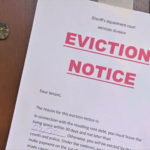A reference of Utah Eviction Laws, and steps of the Utah eviction process for landlords and renters, updated 2021.
- What are the reasons for eviction under Utah eviction laws?
- Nonpayment of rent (Utah Code § 78B-6-802(1)(c))
- Illegal activity (Utah Code § 78B-6-802(1)(g))
- Tenant sublets the property without permission (Utah Code § 78B-6-802(1)(d))
- Tenant sets up an unlawful business on the premises (Utah Code § 78B-6-802(1)(e))
- The tenant commits waste on the premises (Utah Code § 78B-6-802(1)(d))
- The tenant permits a nuisance (Utah Code § 78B-6-802(1)(f))
- Non-compliance with the lease agreement (Utah Code § 78B-6-802(1)(h))
- The tenant remains in possession of the rental unit after the lease term without the owner’s permission (Utah Code § 78B-6-802(1)(b)(i))
- Lease Termination (Month-to-Month): 15 days (§ 78B-6-802(1)(b)(i))
- Nonpayment of rent (Utah Code § 78B-6-802(1)(c))
- Illegal activity (Utah Code § 78B-6-802(1)(g))
- Tenant sublets the property without permission (Utah Code § 78B-6-802(1)(d))
- Tenant sets up an unlawful business on the premises (Utah Code § 78B-6-802(1)(e))
- The tenant commits waste on the premises (Utah Code § 78B-6-802(1)(d))
- The tenant permits a nuisance (Utah Code § 78B-6-802(1)(f))
- Non-compliance with the lease agreement (Utah Code § 78B-6-802(1)(h))
- Tenant remains in possession of the rental unit after the lease term without the owner’s permission (Utah Code § 78B-6-802(1)(b)(i))
- What notice do Utah eviction laws require that landlords provide tenants before starting the eviction process?
- A 3-day notice is required for any of the following reasons:
- Non-payment of rent (three business days)
- Illegal activity
- Subletting the property without permission
- Setting up an unlawful business on the premises
- Committing waste on the property
- Permitting a nuisance on the property
- Non-compliance with the lease agreement (Utah Code § 78B-6-802(1))
- For evictions based on remaining in possession of the rental unit beyond the period of the lease without the owner’s permission, the landlord must provide a notice of 30-days for a month-to-month tenancy. (Utah Code § 78B-6-802(1)(b)(i)).
- A 3-day notice is required for any of the following reasons:
- Do Utah eviction laws allow landlords to use “self-help eviction” methods, such as locking a tenant out of the rental unit or shutting off the utilities?
- No. Utah law prohibits self-help measures. (Utah Code § 78B-6-814).
Utah Eviction Process: Step-by-Step
The eviction process in Utah involves the following five steps:
- The landlord serves the eviction notice. The landlord must legally serve the eviction notice on the tenant through any of the following methods:
- Delivering it personally to the tenant
- Mailing it via certified or registered mail
- Leaving it with a person of “suitable age and discretion” at the rental unit if the tenant is not present, followed by mailing it to the tenant
- Attaching the notice in a conspicuous place at the rental unit if a person of suitable age or discretion cannot be located (Utah Code § 78B-6-805).
- The landlord files an eviction lawsuit. After the waiting period has lapsed, the landlord can begin the judicial eviction process in Utah by filing a lawsuit with the district court in the county where the property is located. The landlord must file a complaint that describes the tenant, the landlord, the property, and the legal justification for the eviction. The landlord must also complete a summons that notifies the tenant of the case against them. Landlords can use the OCAP system to prepare the complaint and summons.
- The landlord serves the tenant. The landlord must have the tenant legally served with the following documents:
- The complaint
- The summons
- The written rental agreement, if any
- The eviction notice that was previously served on the tenant
- Notice to Defendant of Disclosure Requirements in Unlawful Detainer Actions, which describes the tenant’s rights
- An itemized calculation of past-due rent, damages, costs, and attorney’s fees.
The tenant has three days to prepare a written response to the complaint and request a hearing, which is stated in the summons.
- The court hearing is scheduled. The landlord can request a default judgment if the tenant does not respond to the complaint and summons. If the tenant does respond, the hearing is scheduled for within 10 days of the tenant’s answer. Before the hearing, the tenant and landlord must provide each other with the evidence they are planning to use at the hearing.
- The parties attend the hearing. The landlord and tenant attend the hearing and present the case. If the court rules in the landlord’s favor, it provides an Order of Restitution of the Premises, which directs the sheriff or constable to remove the tenant from the rental property.
Depending on the legal claims and outcome, the landlord can recover an Order for Damages, Rent, and Attorney Fees that covers these costs, as well as three times the amount of damages stemming from:- Rent
- Forcible entry
- Damage to the property







